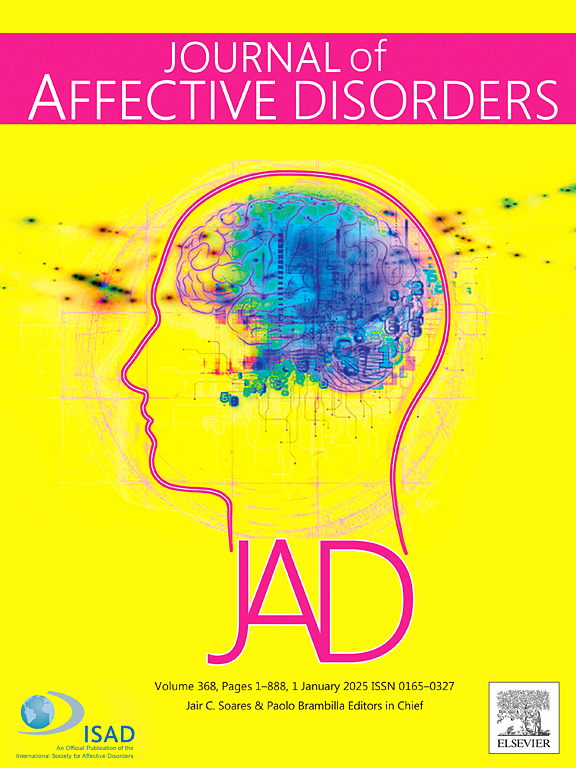Association of childhood emotional neglect, circulating protein biomarkers, with gastrointestinal disorders among UK biobank participants
IF 4.9
2区 医学
Q1 CLINICAL NEUROLOGY
引用次数: 0
Abstract
Objective
To explore the association between CEN and GIDs, and elucidated the potential role of circulating protein biomarkers.
Patients and methods
The study utilized UK Biobank data from 156,686 participants, with data collection occurring between March 13, 2006 and October 1, 2010. Participants with GIDs at baseline were excluded from further analysis. CEN data were obtained from the baseline assessments. Differential protein analyses were conducted using OLINK data. GIDs and their subclasses were identified through electronic health records. Cox proportional hazards regression models were employed to assess the association between CEN and the risk of GIDs, along with sensitivity and multidimensional stratification analyses. Additionally, mediation analysis was performed to explore the role of differential protein biomarkers.
Results
The results indicated that the mild CEN (CENmild) group was associated with a significantly lower risk of various GIDs than the severe CEN (CENsevere) group, including overall GIDs (HR = 0.78,95%CI:0.74–0.81) and peptic ulcers (HR = 0.37,95%CI:0.20–0.68). OLINK differential analysis revealed that APOF expression was significantly higher in the CENmild group compared to the CENsevere group (PAPOF = 7.09E-08,FC = 0.048), whereas other differential protein expression (PBPIFB2 = 8.93E-06,FC = -0.122;PFABP4 = 3.19E-06,FC = -0.101;PGGH = 4.58E-07,FC = -0.054;PLEP = 5.39E-08,FC = -0.195) was significantly lower in the CENsevere group. Cox regression analysis showed that higher APOF expression was associated with a reduced risk of multiple GIDs, while the expression of other differential proteins increased the risk of corresponding GIDs. Mediation analysis indicated that these proteins mediated 0.5 % to 6.7 % of the CEN-GIDs association.
Conclusion
In this cohort study, CEN was significantly associated with a higher risk of GIDs in the adulthood, and circulating protein biomarkers partially mediated the associations.

目的探讨 CEN 与 GID 之间的关联,并阐明循环蛋白生物标志物的潜在作用:该研究利用了英国生物库(UK Biobank)的数据,共收集了156686名参与者的数据,数据收集时间为2006年3月13日至2010年10月1日。进一步分析时排除了基线时患有 GID 的参与者。CEN数据来自基线评估。使用 OLINK 数据进行了蛋白质差异分析。通过电子健康记录确定了 GID 及其子类。采用 Cox 比例危险回归模型评估 CEN 与 GIDs 风险之间的关联,并进行敏感性和多维分层分析。此外,还进行了中介分析,以探讨不同蛋白质生物标志物的作用:结果表明,轻度 CEN(CENmild)组发生各种 GIDs 的风险明显低于重度 CEN(CENsevere)组,包括总体 GIDs(HR = 0.78,95%CI:0.74-0.81)和消化性溃疡(HR = 0.37,95%CI:0.20-0.68)。OLINK 差异分析显示,与重度 CEN 组相比,轻度 CEN 组的 APOF 表达明显较高(PAPOF = 7.09E-08,FC = 0.048),而重度 CEN 组的其他差异蛋白表达(PBPIFB2 = 8.93E-06,FC = -0.122;PFABP4 = 3.19E-06,FC = -0.101;PGGH = 4.58E-07,FC = -0.054;PLEP = 5.39E-08,FC = -0.195)则明显较低。Cox回归分析表明,APOF表达量越高,患多种GID的风险越低,而其他差异蛋白的表达量越高,患相应GID的风险越高。中介分析表明,这些蛋白介导了0.5%至6.7%的CEN-GIDs关联:结论:在这项队列研究中,CEN 与成年后较高的 GIDs 风险显著相关,而循环蛋白生物标志物部分介导了这种关联。
本文章由计算机程序翻译,如有差异,请以英文原文为准。
求助全文
约1分钟内获得全文
求助全文
来源期刊

Journal of affective disorders
医学-精神病学
CiteScore
10.90
自引率
6.10%
发文量
1319
审稿时长
9.3 weeks
期刊介绍:
The Journal of Affective Disorders publishes papers concerned with affective disorders in the widest sense: depression, mania, mood spectrum, emotions and personality, anxiety and stress. It is interdisciplinary and aims to bring together different approaches for a diverse readership. Top quality papers will be accepted dealing with any aspect of affective disorders, including neuroimaging, cognitive neurosciences, genetics, molecular biology, experimental and clinical neurosciences, pharmacology, neuroimmunoendocrinology, intervention and treatment trials.
 求助内容:
求助内容: 应助结果提醒方式:
应助结果提醒方式:


